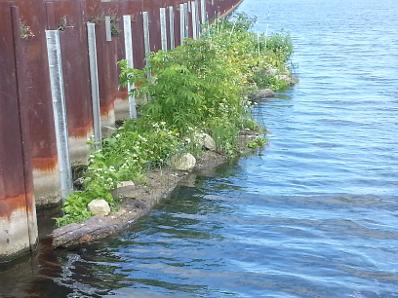
Floating Island at Great Lakes Water Institute, Milwaukee, Wisconsin, USA. Fall, 2013
Photo courtesy of Marek Landscaping, LLC.
Pollutant Removal Using Engineered Island Biological Treatment Systems
Engineered wetlands provide a low cost and aesthetic solution to increasing water quality in urban waterways and industrial surface water discharges. The system provides media for aerobic, or oxygen-loving, micro-organisms to grow and structure for diverse yet concentrated plant life for treatment and plant life.
Algae blooms occur naturally in water systems that have stagnant waters with high nutrient load. When concentrations of phosphorus and nitrogen increase in stagnant waters, and oxygen levels are low, these types of water bodies are called “Eutrophic” or “Eutrophied”. By decreasing nutrient loads, and increasing dissolved oxygen levels, the overall health of water systems can be improved for aestetic and fishlife.
Odors are generated from stagnant waters. The breakdown products from humic matter generates various forms of sulfur smells, like rotten egg, skunk. Specific chemicals or compounds that are generated are mercaptans, sulfides, and hydrogen sulfide (H2S). When the oxygen levels and turnover rates of these stagnant waters are improved, the biological profile changes to aerobic organisms, which generate less odors from breakdown processes.
Targeted Pollutants in System Design
In urban waterways and industrial surface water discharges, engineered floating wetlands are designed to target certain pollutants, while providing rich wildlife habitat structures. Plants chosen for their phyto-remediative qualities are added to a floating structure that can have matrices added for specific pollutant targeting. A combination of sedimentation, filtration and nutrient uptake are the mechanisms that remove the pollutants from the waters.
Free water surface (FWS) systems and (2) subsurface flow systems (SFS). FWS systems are typically constructed in channels or parallel basin with a relatively impermeable barrier structure, emergent vegetation, and shallow water depths of 0.33 to 2 feet (0.1 to 0.6m). Systems are designed with a continuous flow rate and retention time through the wetland; the longer the retention time, the greater the ability for increased pollutant removal.
The chemical makeup of the superstructure can be selected based on adsorptive capacities and chemical precipitation potential from the pH of the material. Phosphorus is commonly found in the form of ortho-phosphates, and is easily adsorbed by certain organic soil fractions and clays.
Plant growth cycles are also an important factor in plant selection. Nitrates are more easily biologically absorbed in systems, but only during periods of active root growth.
Parameters monitored in documenting the pollutant removal capacities of engineered wetlands include:
Chemical Oxygen Demand (COD)
Biochemical Oxygen Demand (BOD)
Total Nitrogen
Total Phosphorus
Dissolved Oxygen (DO)
Operation & Maintenance requirements of engineered wetlands vary but can average one day per week and systems are designed to last 10 years.